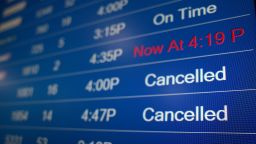It’s the peak of holiday travel season. You paid $189 for a yearly Clear membership to breeze through airport security and cut to the front of the TSA line.
But the flyers who paid a fraction of the price for a TSA PreCheck membership ($78 for five years) are moving faster than you in their dedicated lane. And even people who didn’t pay more are getting ahead of you because there are multiple “regular” lines.
Welcome to the newest pain point in air travel: which security line to choose.
Millions of people are expected to fly this week over the holidays, a 6% increase from last year. Many are essentially trying to cut the line by signing up for relatively new and pricey programs, both governmental and private, that promise to speed you through airport security, shoes on.
But as more and more (and more) people sign up for these programs — which offer convenience in exchange for personal or biometric data — they’re getting slower.
TSA PreCheck members are complaining on social media of longer wait times than regular security in some cases, while Clear members are grumbling that they paid more than TSA PreCheck members for slower service. Travelers are scratching their heads over which to choose.
“It’s a judgement call when you get to the screening checkpoint,” said Jeffrey Price, an airport management consultant and a professor at the Metropolitan State University of Denver’s department of aviation and aerospace science. “Which line is longest and which is going to make me do the least amount?”
Members of both programs must be strategic about getting through security lines, depending on their airport, staffing levels at Clear and TSA, and other factors, say travel and airport management experts.
TSA PreCheck
The Transportation Security Administration’s PreCheck program debuted in 2011 to move frequent flyers more quickly through lines because they were considered lower risk. The US government program was initially restricted and didn’t catch on widely until TSA began accepting new applicants in 2013. By 2016, two million flyers had signed up for TSA Pre.
Enrollment has surged recently. More than 18 million passengers have enrolled in PreCheck, up around 30% from 2022.
TSA wants more passengers to sign up for TSA PreCheck, but wait times have slightly increased as people rush to the program.
TSA said earlier this year that 92% of PreCheck passengers wait less than five minutes to get through security (down from 99% in 2016). But 99% wait less than 10 minutes, TSA said.
More people signing up for TSA PreCheck isn’t the only factor slowing down lines. Some airports have installed 3-D luggage scanning machines. While passengers screened with these machines don’t need to remove small liquids or laptops from their bags, the new machines can take longer. Airlines and airports are also dealing with staffing shortages.
“A lot more people are traveling than anybody anticipated post-Covid. We have a pilot shortage and air traffic shortage,” Price said. “It really is a combination of things that’s causing a person to stand in line longer than necessary.”
Clear
Clear does not let flyers skip physical security screenings at the airport. They are still done by TSA.
But the private security company, which is backed in part by some airlines, allows members to verify their identity at a Clear airport kiosk using biometrics without having to show their ID to a TSA agent. Once a traveler’s identity has been verified, the traveler is escorted by a Clear employee right to the front of a TSA security line.
Clear has grown rapidly, in part due to discounts granted by some credit cards and airline mileage programs. In December 2022, approximately 6% of all TSA checkpoint volume in the US went through a Clear lane, compared to 4% the year prior, according to the latest Clear data.
Yet it can sometimes be counterproductive to use Clear instead of TSA PreCheck, said Henry Harteveldt, who covers the travel industry for Atmosphere Research Group.
Delta, based in Atlanta, and United, out of Chicago, have invested in Clear. Travel experts say Clear lines are often longest at Atlanta’s Hartsfield-Jackson airport and Chicago O’Hare.
TSA has been also checking IDs at Clear more frequently after security lapses, slowing down the process, Harteveldt said.
“The @Clear line is 4x the PreCheck line. Each person takes longer at CLEAR than the @TSA document check,” Gary Leff, an airline industry expert and the founder of the travel website View From the Wing, posted on X this month.
“As more people have gotten it, Clear is more useful a smaller percentage of the time,” Leff told CNN.
A Clear spokesperson said the company has increased its airport staffing to assist members during the busy holiday season. The company also plans to add more lanes and new technology to minimize waits.
Still, when TSA PreCheck and Clear lines are equally as long, Leff opts for the cheaper program.
“I use the PreCheck line since it currently takes longer to verify the identity of each passenger through the Clear lane,” he said.





